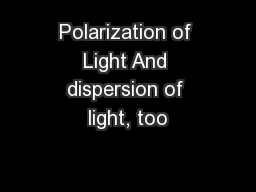

Dispersion of light Visible light full spectrum wavelengths range from 400 nm to 700 nm Different wavelengths have ever so slightly different indices of refraction when passing through materials such as glass plastic or water and probably others ID: 722866
Download Presentation The PPT/PDF document "Polarization of Light And dispersion of ..." is the property of its rightful owner. Permission is granted to download and print the materials on this web site for personal, non-commercial use only, and to display it on your personal computer provided you do not modify the materials and that you retain all copyright notices contained in the materials. By downloading content from our website, you accept the terms of this agreement.
Slide1
Polarization of Light
And dispersion of light, tooSlide2
Dispersion of light
Visible light = full spectrum
wavelengths range from 400 nm to 700 nm
Different wavelengths have ever so slightly different indices of refraction when passing through materials such as glass, plastic, or water (and probably others)
Dispersion
is the effect of these differences on the appearance of refracted light:
https://phet.colorado.edu/sims/html/bending-light/latest/bending-light_en.html
Slide3
Dispersion of Light
Longer wavelengths tend to refract less than the shorter wavelengths, thus resulting in the very familiar rainbow patternSlide4
Rainbow from Airplane
Picture courtesy of Caroline B.
Slide5
What IS Polarization?
First…we have to understand what light is:
http://hyperphysics.phy-astr.gsu.edu/hbase/waves/emwavecon.html
Slide6
Electromagnetic Radiation
Electric fields and magnetic fields vary in strength simultaneously and perpendicularly to each other.
Both
E
and
B
vary following a sinusoidal pattern, resulting in what appears to be a transverse wave…but one that does not require a medium.
Electric and magnetic fields exist in the vacuum of space, so EM waves (light) can travel through space.Slide7
Polarization
Plane Polarization
refers to a wave that is only oscillating in a single fixed plane (i.e. a wave on a string)
Light
normally propagates in all directions:Slide8
Polarized light…
When light passes through a polarizer, The electric field will only oscillate in 1 direction (it’s okay to ignore the magnetic field when talking about polarization…):Slide9
Warm-up
Polarization
1
2
3
a) only case 1
b) only case 2
c) only case 3
d) cases 1 and 3
all
three
cases
none of the cases
If unpolarized light is incident from the left, in which case will some light get through?
Explain your reasoning.Slide10
Question 24.9
Polarization
1
2
3
In cases 1 and 3, light is blocked by the adjacent horizontal and vertical polarizers. However, in case 2, the
intermediate 45° polarizer allows some light to get through
the last vertical polarizer.
a) only case 1
b) only case 2
c) only case 3
d) cases 1 and 3
e) all three cases
If unpolarized light is incident from the left, in which case will some light get through?
Slide11
Polarizers and Analyzers
Polarizer:
A material that has a molecular structure that will only allow one specific orientation of electric field (from the light) to pass through.
Analyzer:
A polarizer that is specifically used to determine if light is polarized (and in what direction)Slide12
Example: LCD displaysSlide13
What’s happening here?Slide14
When light reaches a surface of a transparent or semi-transparent material, much of the light will be able to pass through the boundary and will refract as it passes into the new medium, following Snell’s Law
Some of the light will reflect off the surface, following the law of reflection
Polarization of Reflected LightSlide15
At one particular angle, the reflected light will be fully plane polarized (rather than partially polarized)
The angle of incidence at which this occurs is called the
Brewster’s Angle
The reflected ray and the refracted ray will be perpendicular to each other!
Brewster’s AngleSlide16
and
Brewster’s Angle—
How can it be determined?Slide17
Brewster’s Angle depends on the indices of refraction for the 2 media, and nothing else.
The angle between the angle of refraction and the angle of reflection is
always 90°
at the Brewster’s Angle
Brewster’s Angle—
noteworthy notesSlide18
Most common method of producing polarized light is by using filter
When 2 filters are used in sequence, the first polaroid the light passes through is called the
Polarizer
The second filter the light passes through is called the
Analyzer
Polarizing Filters (Polaroids)Slide19
Exploration lab: Polarization
You will now be determining the relationship between the angle the electric field makes with a polarizer and the intensity of the light that passes through the polarizer
Use the Light Intensity meter and the polarization equipment provided.
Attach the light intensity meter to a ring stand so that it is positioned directly in the center of the polarizer
Choose one of the polarizing filters to be the "polarizer", and maintain the position of that filter so that "0" is always in the same position.
The other filter will be the analyzer, and you will rotate it every 5° and record the light intensity throughout the entire 360°Slide20
The intensity of the light that passes through two
polaroids
is dependent on the angle measured between their two polarizing axes.
I
0
the intensity of the light incident upon the analyzer
I the intensity of the light after passing through the analyzer
q
the relative angle between the polarizer’s and the analyzer’s axis
Malus
’ Law